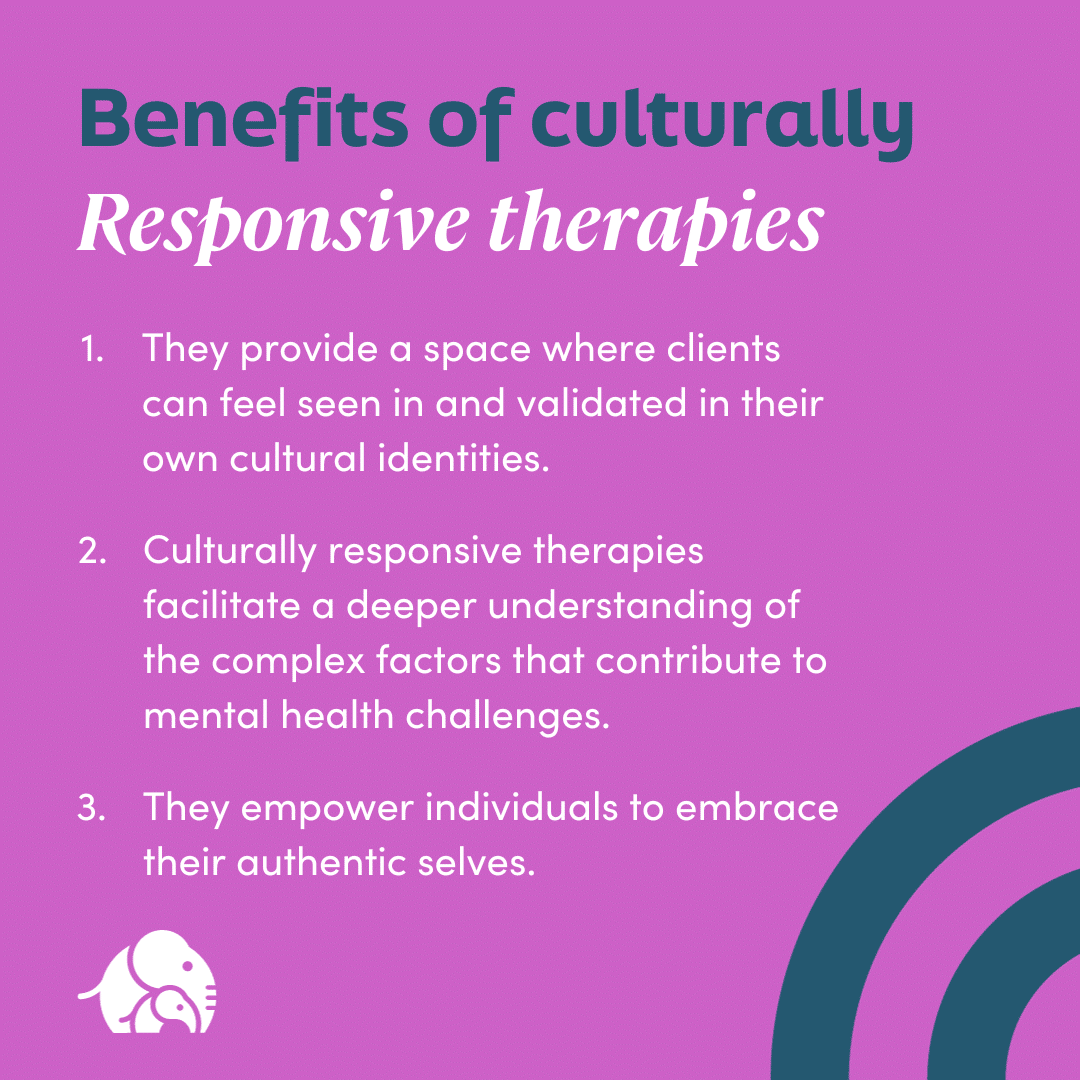Culturally responsive therapies go a step further than conventional approaches, offering a transformative space where clients can be seen, heard, and understood within the context of their cultural identities. By integrating cultural awareness, sensitivity, and respect into therapeutic practices, these approaches foster a sense of trust and create opportunities for profound growth and healing.
Benefits of Culturally Responsive Therapies

They provide a space where clients can feel seen and validated in their cultural identities.
This validation is particularly important for individuals from marginalized or underrepresented communities, who may have historically experienced stigma or discrimination. By embracing clients’ cultural backgrounds, therapists foster a sense of belonging and promote self-acceptance.
Culturally responsive therapies facilitate a deeper understanding of the complex factors that contribute to mental health challenges.
By examining the intersectionality of culture, race, ethnicity, gender, sexuality, and other social identities, therapists can better identify and address the root causes of distress. This holistic approach allows for a more comprehensive and effective treatment plan.
They help individuals to embrace their authentic selves.
By incorporating culturally relevant practices, rituals, and storytelling, clients can reconnect with their cultural heritage and draw strength from their traditions. This integration of cultural elements into the therapy process encourages a sense of pride, resilience, and self-empowerment.
There are several modalities that are considered culturally responsive that can be used in sessions where cultural sensitivity is a factor. Therapies like Narrative Therapy, CBT, and EMDR are all therapeutic approaches that can cater to the cultural differences of the clients they serve. In this blog post we will dive into some of these therapy modalities, but keep in mind that there are many other modalities that could be considered culturally responsive too!
Narrative Therapy
Storytelling is at the root of many cultures and groups, and narrative therapy allows for the client to tell their own story and experiences. It allows for the client to provide culturally specific context and connection while in the therapeutic setting. Through storytelling the client is also providing the therapist the opportunity to see their circumstances, mental health concerns, and cultural needs as individual instead of assumptions.
The narrative therapy approach allows for the client to set the narrative around their own mental health, which is especially important in connecting with a client whose culture or experiences differ from that of the therapist. Narrative therapy is based on these four pillars.
- There is no truth, just simply different interpretations of the reality. This statement speaks to meaning and how it is constructed in social, cultural and political contexts instead of what is wrong or right.
- All people use narrative (stories) to create meaning. Our lives are lived based on the stories we tell ourselves or the stories others tell about us.
- Culture is collected stories of a people. People’s lives create culture which is the most influential determinant in a person’s life.
- The problem is the problem, it is never the person.
Narrative therapy allows for the client and therapist to connect by allowing the client to express their anxiety, depression and mental health concerns through storytelling.
Cognitive Behavioral Therapy
CBT is used to help a client cope with situations that happen in their life, and how their behavior is affected by those situations. Therapists that can see how the client’s behaviors is connected to their cultural experiences render much more of an impact than those that do not consider cultural factors. Therapy should always be personalized for the client instead of creating a blanket approach to how we work with our clients being more intentional with the tools used in CBT.
CBT claims that the main five components in any problem are cognition, emotions, physiological reactions (physical sensations and symptoms), behavior and the environment. When thinking about being more culturally responsive, therapists must remember to be mindful of how the cultural environment of a client may impact their behaviors directly and those factors may be in many cases avoidable. Learning to work around factors within the CBT therapy is an important aspect of being a culturally responsive therapist when using CBT.
EMDR (Eye Movement Desensitization and Reprocessing Therapy)
EMDR is evidence-based for treating trauma, but it can be used for racial and cultural trauma as well. EMDR teaches practitioners: “A culturally competent clinical attitude is a state of mind that inherently understands and respects the role of culture in our society and in individual clients’ lives. This attitude embraces a multicultural perspective that values diversity along many dimensions.”
EMDR is a tool for those who may be struggling with cultural trauma, and it allows a client address the trauma that they may have experienced head-on. This can include being present in the trauma memory to promote understanding and change. When EMDR is used with clients that have experienced cultural or racial trauma, the understanding of the trauma, racial influences, and how the client processed those traumas are all addressed.
Addressing traumatic experiences in therapy, including trauma related to discrimination and racism, can unlock some distressing memories or feelings around times of day, events, and even family or work environments. It is a helpful tool to help clients unlock why they are experiencing racial anxiety, PTSD related to work and even depression around previous experiences in their life.
Culturally responsive therapies play a vital role in fostering mental health and well-being within diverse populations. If you are a client looking for a therapist, it may be helpful to start with clinicians that use these modalities. As mental health professionals continue to expand their knowledge and practice, the integration of culturally responsive therapies will undoubtedly shape the future of mental healthcare, ensuring that all individuals receive the support they need in a culturally sensitive and empowering manner.
References
EMDR Institute, Inc. (2020). What is EMDR? Retrieved from https://www.emdr.com/what-is-emdr/
Hays, P. (2019). Culturally Responsive Cognitive Behavior Therapy, Second Edition: Practice and Supervision. Retrieved from https://www.apa.org/pubs/books/Culturally-Response-Cognitive-Behavioral-Therapy-Second-Edition-Intro-Sample.pdf


